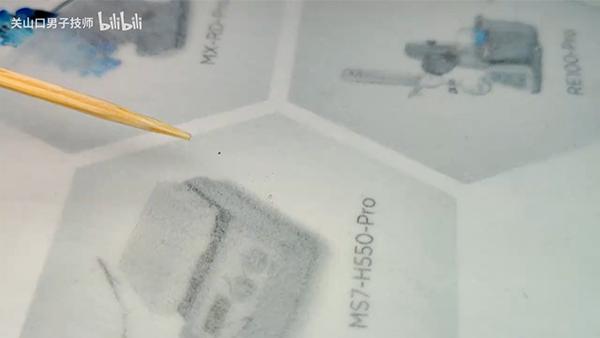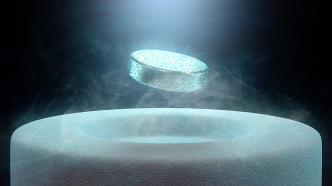

On August 1, Huazhong University of Science and Technology released a video about the repeated experiment of LK-99 material on the domestic website Bilibili (Station B), which became popular on social media at home and abroad.
They are considered by some media to be the first team claiming to have successfully replicated and reproduced LK-99, and their sample "suspension" angle is larger than that of the Korean team.
LK-99 is the world's first room temperature and pressure superconducting material - a copper-doped lead apatite material - announced by the relevant research team of the Korea Quantum Energy Research Center in two preprinted papers about a week ago.
In response to the aforementioned video and its content, on August 1, a researcher in the field of superconductivity told The Paper that "without full suspension, superconductivity is impossible." "Maybe it's ferromagnetic, maybe it's diamagnetic...not necessarily superconducting."
In addition, some researchers said that the above-mentioned video is different from the release of formal academic achievements, but closer to science popularization and publicity.
The above repeated experiments were completed by a research team led by Professor Chang Haixin from the School of Materials Science and Engineering, Huazhong University of Science and Technology.
The research team of Huazhong University of Science and Technology released a video: "For the first time, the LK-99 crystal that can be magnetically levitated has been verified and synthesized"
According to previous reports from The Paper, on the morning of July 22, the relevant research team of Korea Quantum Energy Research Center submitted two similar papers on the preprint website arXiv, claiming that a copper-doped lead phosphor named LK-99 Stone materials have "room temperature + normal pressure" superconducting ability. However, the experimental data released so far are considered by industry insiders to be insufficient to prove that LK-99 is a superconductor.
Subsequently, a number of international research teams began to repeat experiments, attempting to synthesize LK-99 in order to reproduce the experimental results of the Korean team.

The experimental steps and final samples of LK-99 synthesized by the related research team of Korea Quantum Energy Research Center Corporation.
On July 29, the UP owner (video publisher) of the Bilibili website of Huazhong University of Science and Technology "Guanshankou Male Technician" released a message saying, click the appointment button, and don't miss the live broadcast—"Live broadcast reservation: Superconducting LK99 , Verification Experiment", and started the live broadcast of the verification experiment on July 31.
At about 23:00 on July 31, regarding the "fired" first batch of LK-99 samples, the above-mentioned UP master issued a message saying, "There is antimagnetic, but it is relatively weak. There is no zero resistance , and the whole is a semiconductor curve. It is estimated that if there is The superconducting phase, which is also a trace amount of superconducting impurities, cannot form a continuous superconducting pathway."
At 14:53 on August 1, the UP master posted a message saying, "My mentor (teacher) made me no longer anonymous."
At 15:08 on August 1, the UP master released a video titled "LK-99 Verification", with a total duration of 3 minutes and 53 seconds.
The introduction of the video reads, "Postdoctor Wu Hao and doctoral student Yang Li of the School of Materials Science and Technology, Huazhong University of Science and Technology, under the guidance of Professor Chang Haixin, successfully verified and synthesized the LK-99 crystal that can be magnetically levitated for the first time . The magnetic levitation angle of the sample obtained by Lee et al. is larger, and it is expected to realize the true non-contact superconducting magnetic levitation.”
At 15:21 on the same day, the UP master released and pinned an English message saying, " For the first time , it has been successfully verified that the LK-99 crystal can be used at room temperature in a larger sample than Sukbae Lee (the first author of the Korean LK-99 paper) sample." levitation angle for magnetic levitation".
The playback volume of the above-mentioned video has been rising all the way, and once reached the second place in the ranking list of the Bilibili website. As of 13:00 on the 2nd, the number of broadcasts has exceeded 6.563 million, and the number of comments has reached 48,000.
The video screen shows that the relevant experimental samples are placed under a lens similar to a microscope, and then the observed screen is displayed on a display screen. The experimenters said that a black dot on the screen was the sample material they got. The sample is in the shape of flakes, the color is yellow and black in different shades, and the shape is close to triangle. Place the NdFeB magnet under the sample stage, and the sample sheet is upright and turned over. The experimenter said, "Whether it is the N pole or the S pole, its force on this (thin) sheet is a repulsive force."

In response to the aforementioned two videos, a large number of netizens left messages of congratulations and "group photos".
However, some netizens said that at present, only the LK-99 material has been reproduced, which has confirmed some phenomena, but it is not a superconductor, and further experiments are yet to be done. "I can only say let the bullet fly for a while", "How about the resistivity? Have you measured it?" "We can talk after the zero resistance is measured."
The above-mentioned UP owner said, "Measuring resistance requires adding a micronano (work) and destroying the sample." "At present, there is only a very small sample, and I dare not move it, I really dare not move it." The third batch of samples is being "fired" urgently.
Huazhong University of Science and Technology related website introduction, Chang Haixin, male, born in 1980, professor of the School of Materials Science and Technology of Huazhong University of Science and Technology, doctoral supervisor, national overseas high-level talent, head of the Quantum Nano Materials and Devices Laboratory; in 2007 in the Chinese Academy of Sciences Metal Research Received a Ph.D. in Materials Science; has long been engaged in the research of two-dimensional and quantum materials such as graphene, low-dimensional physics and nano-devices, new energy materials and devices, etc.
Other researchers: It is not an official academic release, and the samples in the video are not necessarily superconductors
Regarding the aforementioned video released by the relevant team of Huazhong University of Science and Technology, some researchers in the field of superconductivity told The Paper that the samples tested in the video were not necessarily superconductors. The fact that the sample flakes can stand upright when the magnet is close to it cannot prove the Meissner effect.
In addition, some researchers said that under normal circumstances, research data and academic achievements are mainly released through publishing peer-reviewed papers, giving speeches at academic conferences, and holding press conferences. The aforementioned video of Huazhong University of Science and Technology was released on the relevant website, of course, it is not a formal way of releasing academic achievements. "There may be various reasons, such as showing it to give everyone a signal. " The sample is completely antimagnetic; the research team should perform more characterization and testing on the sample before publishing the paper.
The UP master who posted the aforementioned video also said in the comment area of station B, "(The video is) to claim ( announce ) first."
So far, at least three new papers on LK-99 have been published on the preprint website arXiv. Two of them are from China.
At 18:04 on July 29, Liu Peitao, a researcher at the Institute of Metal Research, Chinese Academy of Sciences, submitted a paper on the preprint website arXiv. According to the paper, according to theoretical calculations, LK-99 has a unique electronic structure and the possibility of room temperature superconductivity; compared with silver, gold exhibits a doping effect more similar to copper.

The research team of Beihang University submitted a preprint paper stating that no magnetic levitation was observed in repeated experiments.
At 16:13 on July 31, the team of Professor Liu Zhiqi from the School of Materials Science and Engineering of Beihang University submitted a paper on the preprint website arXiv. According to the paper, the room temperature resistance of the LK-99 sample is not zero, and no magnetic levitation phenomenon has been observed; the material is similar to a semiconductor, not a superconductor.



This is nicely put! ! web page Kudos. A good amount of knowledge! casino en ligne Great data Many thanks! casino en ligne You mentioned this effectively. casino en ligne Whoa a good deal of very good material. casino en ligne Thanks a lot! Fantastic stuff! casino en ligne Seriously quite a lot of great information. casino en ligne Wonderful content, Thanks. casino en ligne Thanks! A good amount of postings. casino en ligne Seriously lots of valuable data. casino en ligne